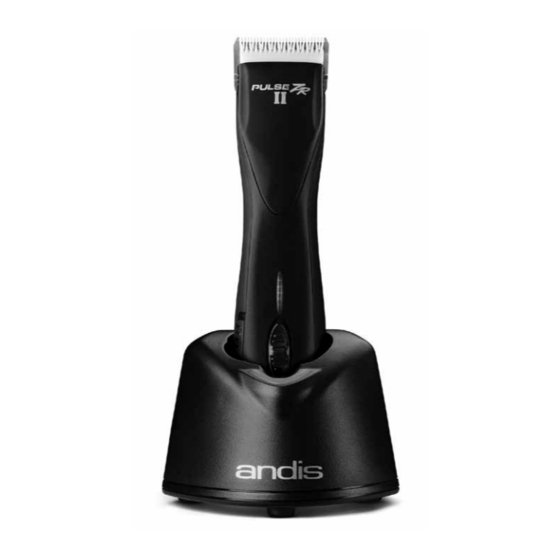Andis DBLC-2 Manual de Instruções de Utilização e Cuidados - Página 5
Procurar online ou descarregar pdf Manual de Instruções de Utilização e Cuidados para Equipamento comercial para alimentos Andis DBLC-2. Andis DBLC-2 18 páginas.

BLADE TEMPERATURE
Due to the high speed nature of Andis clippers, please check for blade heat
often, especially on close cutting blades. If blades are too hot, dip the blades
only into Andis Blade Care Plus or apply Andis Cool Care Plus and then Andis
Clipper Oil. If you have a detachable blade unit, you can change your blade in
order to maintain a comfortable temperature; using multiple blades of the same
size is popular among groomers.
CARE AND SERVICING OF YOUR ANDIS CLIPPER BLADES
Blades should be oiled before, during, and after each use. If your clipper blades
leave streaks or slow down, it's a sure sign blades need oil. The clipper should be
held in the position shown in Figure N to prevent oil from getting into the motor.
Place a few drops of Andis Clipper Oil on the front and side of the cutter blades
(Figure O). Wipe excess oil off blades with a soft dry cloth. Spray lubricants
contain insufficient oil for good lubrication, but are an excellent clipper blade
coolant. Discontinue use of broken or nicked blades to prevent injury. You can
clean the excess hair from your blades by using a small brush or worn out
toothbrush. To clean the blades we suggest to immerse the blades only into a
shallow pan of Andis Blade Care Plus, while the clipper is running. Any excess
hair and dirt that has accumulated between the blades should come out. After
cleaning, turn your clipper off and dry blades with a soft, dry cloth and start
clipping again.
If upon cleaning your blades you find that the blades will still not cut, there may
be a few fine pieces of hair trapped between the upper and lower blade. If this
happens, you will need to snap the blade off the clipper. Proceed to slide the
upper blade to one side, without loosening the tension spring or moving the
upper blade completely out from under the tension spring (See Figure P for
position of blade). Wipe the surface between the blades clean with a dry cloth,
then place a drop of clipper oil where the upper and lower blades meet and also
in the guide slot of the tension spring (Figure P). Now slide the upper blade to
the opposite side of the lower blade and repeat this process. After completing
this procedure, slide the upper blade, centering it over the lower blade. Handle
or store your Andis clipper with the blades down so excess oil will not run into
the clipper case.
CHANGING THE BLADE DRIVE ASSEMBLY
If your clipper blades no longer cut properly (be sure to try more than one blade,
since the blade currently being used may be dull), it could be that your blade
drive assembly needs replacement.
TO CHANGE THE BLADE DRIVE ASSEMBLY:
1. Remove blade set (Figure L).
2. Remove drive cap by grabbing both sides at top and sliding off (Figure Q).
8
3. Remove blade drive mounting screws (Figure R).
4. NOTE: Before removing blade drive assembly, note the way it is positioned
(this will help you in reassembly). Remove blade drive assembly (Figure S).
5. Drive bearing should be at its lowest position (See Figure T for correct position
of drive bearing), if not, move it with your finger to lowest position (See Figure
U for incorrect position of drive bearing).
6. Put on new drive assembly, align screw holes and press down (Figure S).
7. Reassemble blade drive by mounting screws (Figure R).
8. Replace drive cap by sliding back on clipper into position (Figure Q).
9. Replace blade (Figure L).
USE GUIDELINES FOR LITHIUM-ION BATTERIES
1. The lithium-ion battery included with your clipper does not develop a
"memory effect" like a nickel-metal hydride (NiMH), or nickel cadmium (NiCd)
battery. You can return the clipper to the charger at any time for a full charge,
or even use the battery before a charge cycle is complete. Like most
rechargeable batteries, lithium-ion batteries perform best when used frequently.
2. For maximum battery life, store the clipper in a partially discharged condition if
the unit will be unused for several months. To discharge the battery, run the
clipper just until the yellow light turns ON.
3. Avoid locating the clipper near heat vents, radiators, or in direct sunlight.
Optimum charging will result where the temperature is stable. Sudden
increases in temperature can result in the battery receiving less than a full
charge.
4. Many factors influence lithium-ion battery life. A battery that has received
heavy use or is more than a year old may not give the same run-time
performance as a new battery pack.
5. New lithium-ion batteries, unused for a period of time, may not accept a full
charge. This is normal and does not indicate a problem with the battery or
charger. The battery will accept a full charge after several cycles of clipper use
and recharging.
6. Disconnect the charger or the clipper from the AC outlet if extended periods
of non-use are anticipated.
SAFETY RULES FOR CHARGER AND BATTERY PACK
1. Do not insert metallic objects into the battery pocket of the charger base.
2. Do not expose the charger to excessively dirty locations. If the charger pocket
becomes clogged with dust or hair, unplug the charger and gently remove hair
or other debris with a soft brush or vacuum cleaner.
3. To clean external parts of the charger, use a soft brush or damp cloth. Do not
use harsh abrasives, detergents, or solvents.
4. Do not use the charger designed for the Andis DBLC-2 clipper to attempt to
charge any other battery.
9
